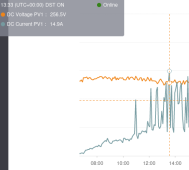The bit that surprises me is "Amps do not rise above 10.3A on each string, at any time." as I have the same panels (actually I've got the slightly lower rated 385W version) and I've seen over 13A. Yes, I know that's higher than even their rated Isc, but it's what my inverter reports. I might be enough to cause the reported problem.

Last edited:


